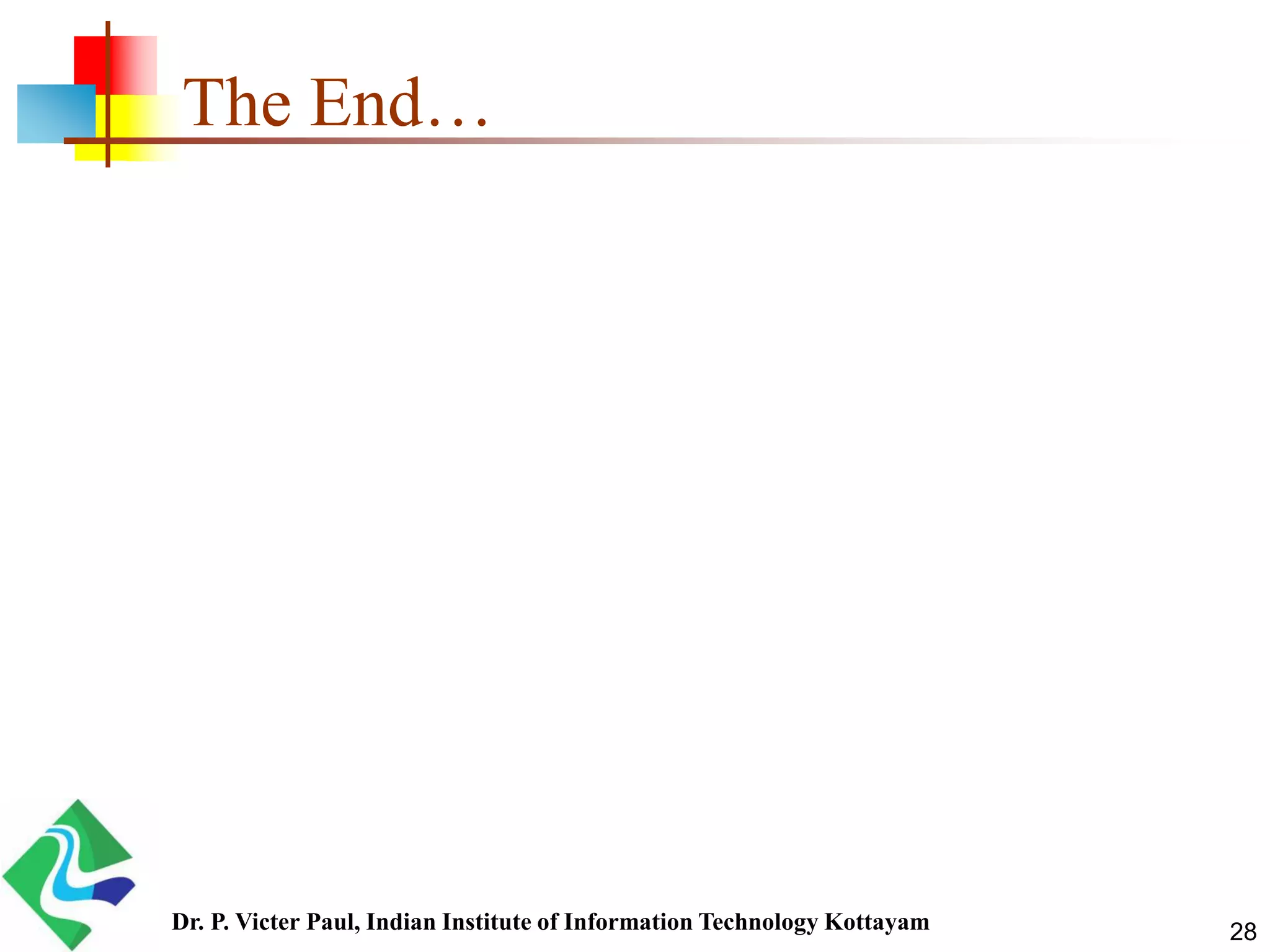The document discusses arrays in Java. It defines an array as an ordered collection of similar items that have a single name and are accessed by their index position. Arrays can be one-dimensional or multi-dimensional. The key points covered include declaring and initializing array variables, accessing and modifying array elements, passing arrays to methods, and returning arrays from methods. Examples are provided for common array operations like summing elements, finding the largest/smallest value, and more.
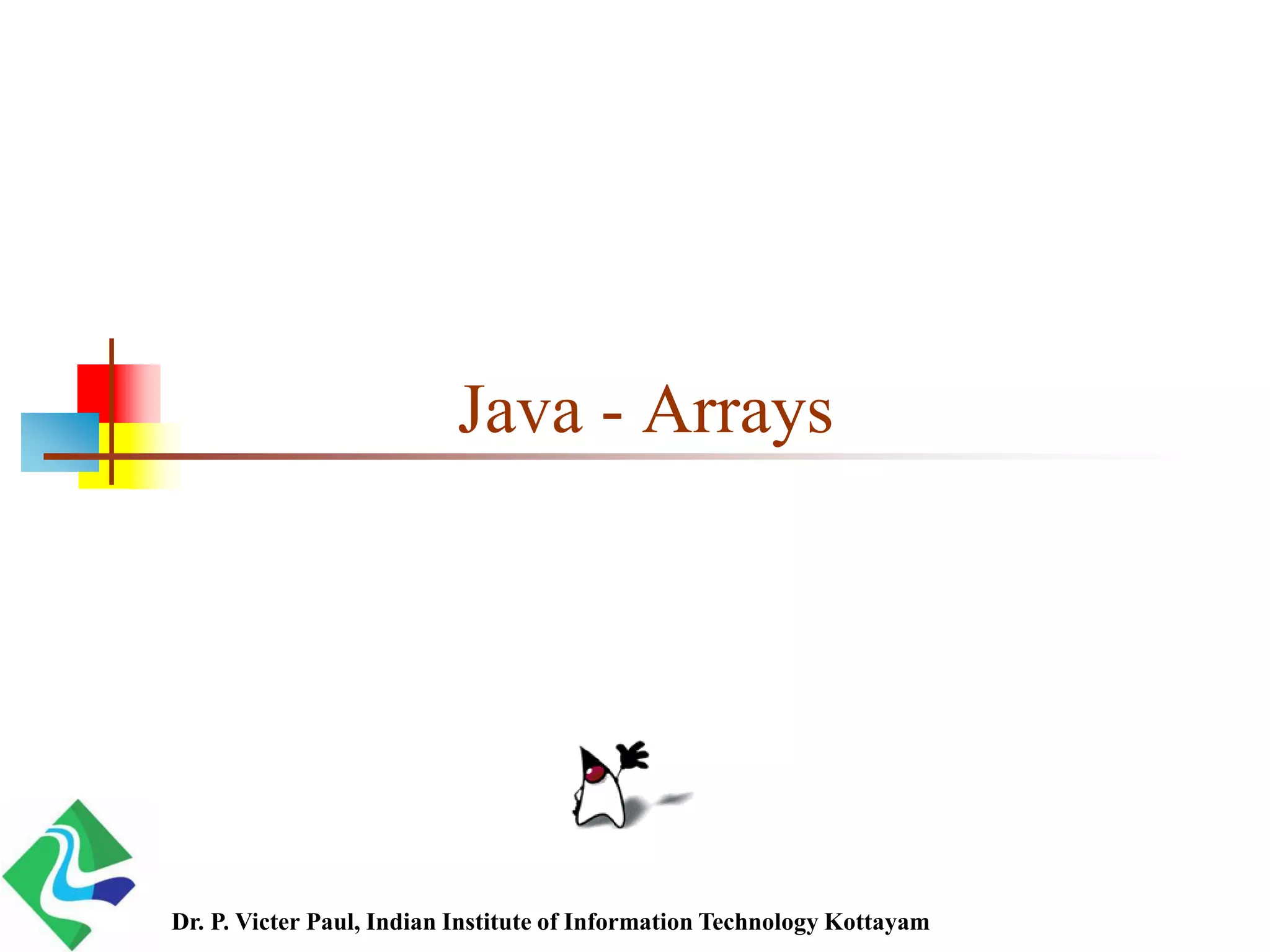
![Introduction
An array is a data structure that consists of an ordered
collection of similar items.
An array has a single name.
The items in an array are referred / accessed in terms of
their position / index in the array.
The items in an array are called elements.
All of the elements need to be of the same type.
The type can be any primitive or reference type.
The length of an array is measured by the number of
elements.
The first element is element[0], the second is
element[1], etc.
An item’s position with an array is its index or subscript.
2Dr. P. Victer Paul, Indian Institute of Information Technology Kottayam](https://image.slidesharecdn.com/java-arraysconcepts-200510150556/75/Java-Arrays-Concepts-2-2048.jpg)
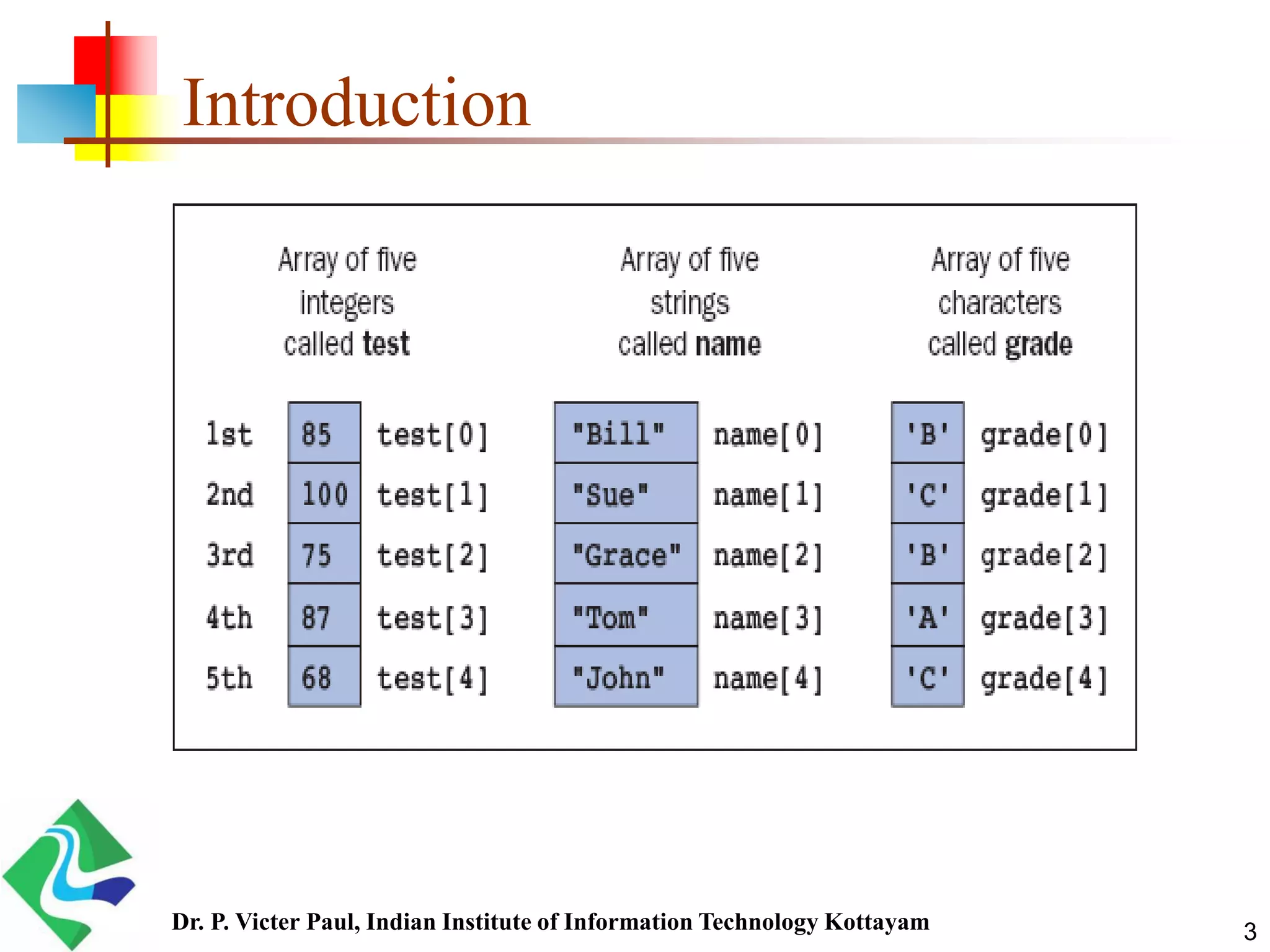
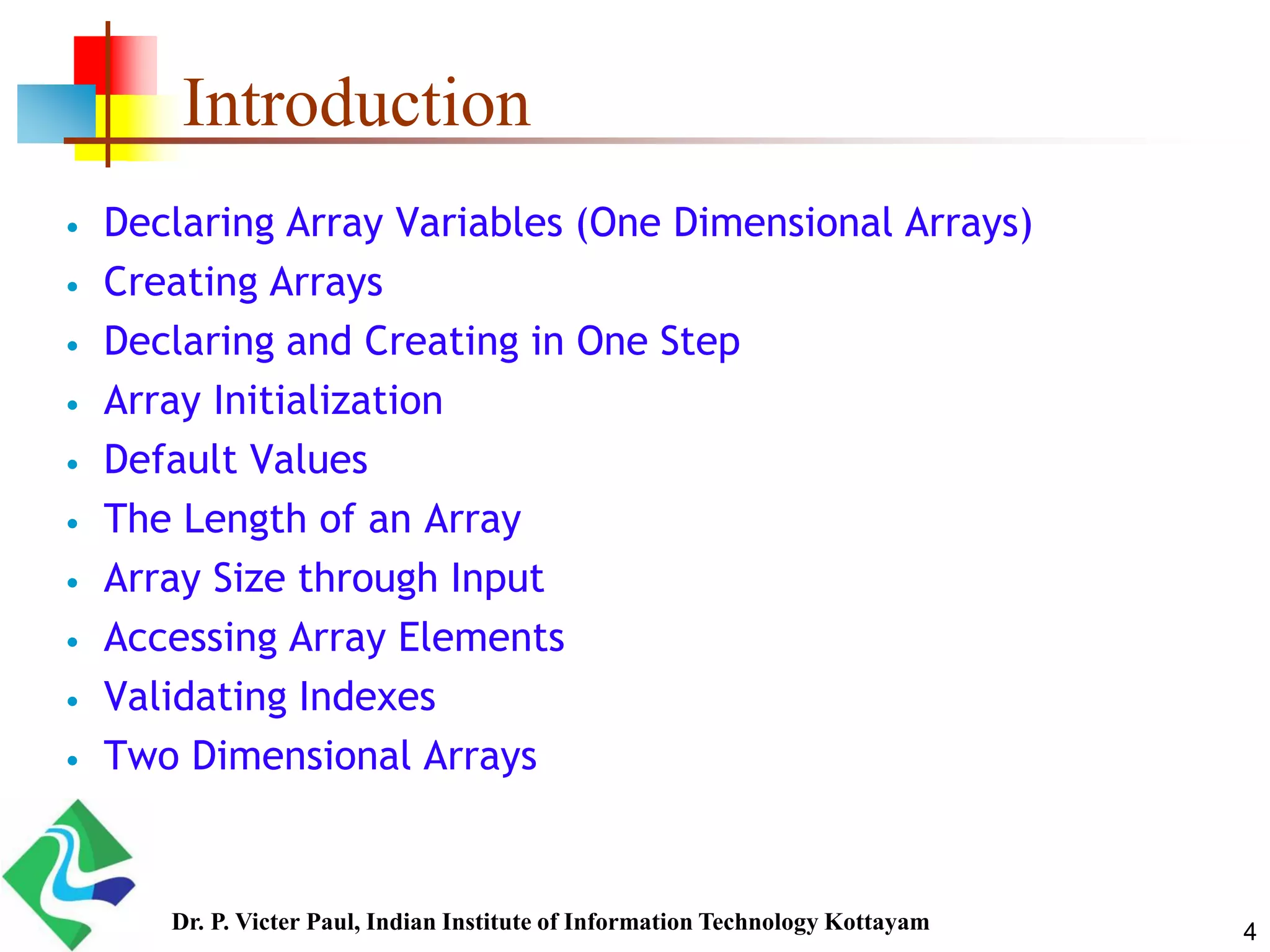
![Declaring Array Variables
Syntax: datatype[] arrayRefVar;
Example: double[] myList;
Alternative syntax: datatype arrayRefVar[];
// This style is allowed, but not preferred
Example:
double myDouble[];
Int[] myInt;
5Dr. P. Victer Paul, Indian Institute of Information Technology Kottayam](https://image.slidesharecdn.com/java-arraysconcepts-200510150556/75/Java-Arrays-Concepts-5-2048.jpg)
![Creating Arrays
Syntax:
arrayRefVar = new datatype[arraySize];
Example:
myDouble = new double[10];
myDouble[0] references the first element in the array.
myDouble[9] references the last element in the array.
myInt = new int[5];
6Dr. P. Victer Paul, Indian Institute of Information Technology Kottayam](https://image.slidesharecdn.com/java-arraysconcepts-200510150556/75/Java-Arrays-Concepts-6-2048.jpg)
![Declaring and Creating in One Step
Syntax:
datatype[] arrayRefVar = new datatype[arraySize];
Example: double[] myDouble = new double[10];
Alternative Syntax:
datatype arrayRefVar[] = new datatype[arraySize];
Example: int myInt[] = new int[10];
String[] myString = new String[5];
MyClass[] myObject= new MyClass[2]; //object
7Dr. P. Victer Paul, Indian Institute of Information Technology Kottayam](https://image.slidesharecdn.com/java-arraysconcepts-200510150556/75/Java-Arrays-Concepts-7-2048.jpg)
![Array Initializers
Java has a shorthand notation to declare, create, and
initialize an array in one statement:
double[] myList = {1.9, 2.9, 3.4, 3.5};
This shorthand notation is equivalent to the following
statements:
double[] myList = new double[4];
myList[0] = 1.9;
myList[1] = 2.9;
myList[2] = 3.4;
myList[3] = 3.5;
8Dr. P. Victer Paul, Indian Institute of Information Technology Kottayam](https://image.slidesharecdn.com/java-arraysconcepts-200510150556/75/Java-Arrays-Concepts-8-2048.jpg)
![CAUTION
This shorthand syntax must be in one statement
The following is incorrect:
double[] myList = new double[4];
myList= {1.9, 2.9, 3.4, 3.5};
9Dr. P. Victer Paul, Indian Institute of Information Technology Kottayam](https://image.slidesharecdn.com/java-arraysconcepts-200510150556/75/Java-Arrays-Concepts-9-2048.jpg)
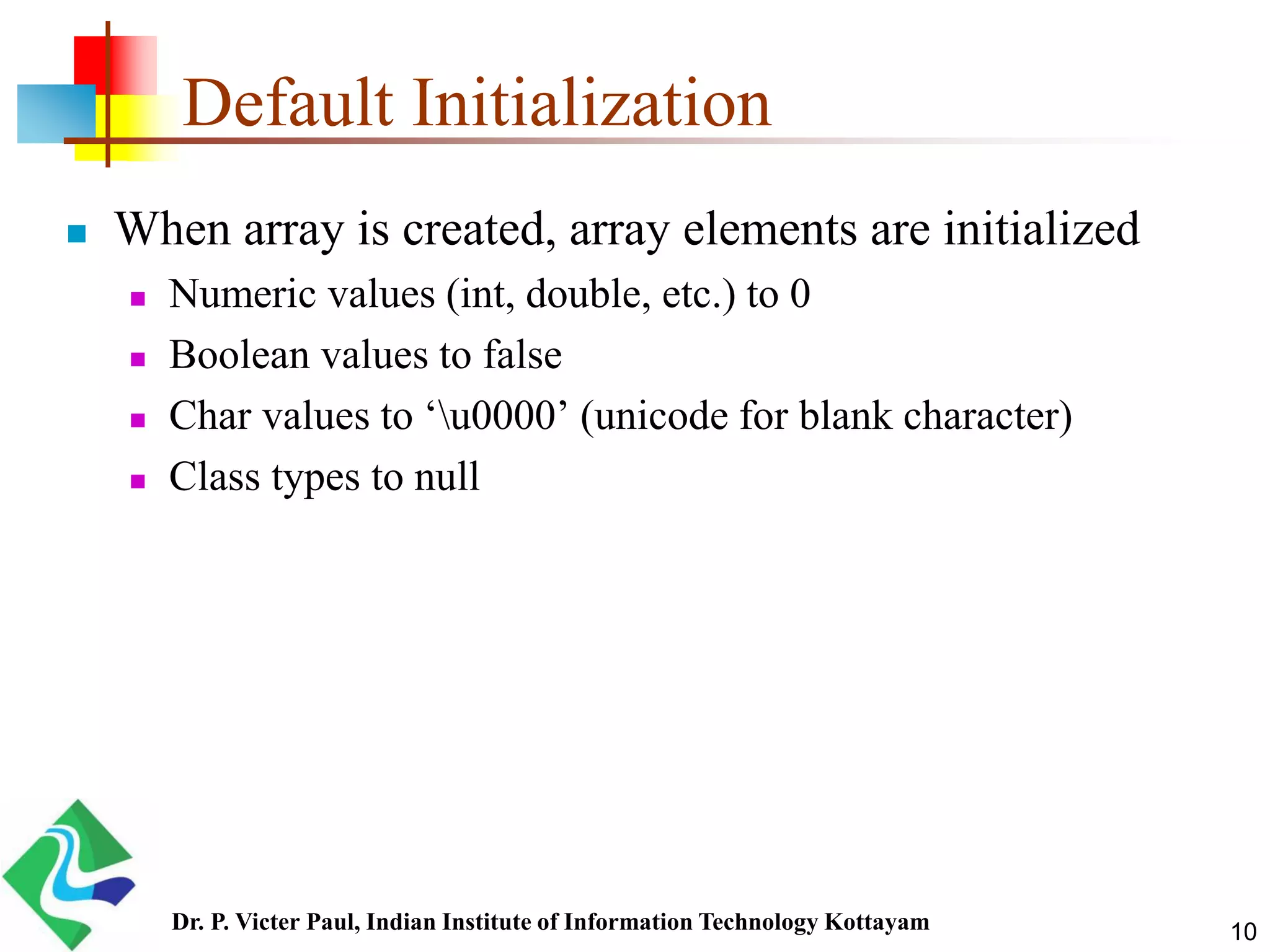
![The Length of an Array
Once an array is created, its size is fixed
Array size cannot be changed
We can find its size using the following syntax:
arrayRefVar.length
Note that length is a constant, not a method
There is no parentheses following length
For example, myList.length returns 10
myInt.length
Sample Code:
long[] primes = new long[20];
System.out.println(primes.length);
Output: 20
11Dr. P. Victer Paul, Indian Institute of Information Technology Kottayam](https://image.slidesharecdn.com/java-arraysconcepts-200510150556/75/Java-Arrays-Concepts-11-2048.jpg)
![Accessing Array Elements
Index of an array is defined as
Positive int, byte or short values
Expression that results into these types
Any other types used for index will give error
long, double, etc.
Incase Expression results in long, then type cast to int
Indexing starts from 0 and ends at N-1
primes[2]=0;
int k = primes[2];
…
12Dr. P. Victer Paul, Indian Institute of Information Technology Kottayam](https://image.slidesharecdn.com/java-arraysconcepts-200510150556/75/Java-Arrays-Concepts-12-2048.jpg)
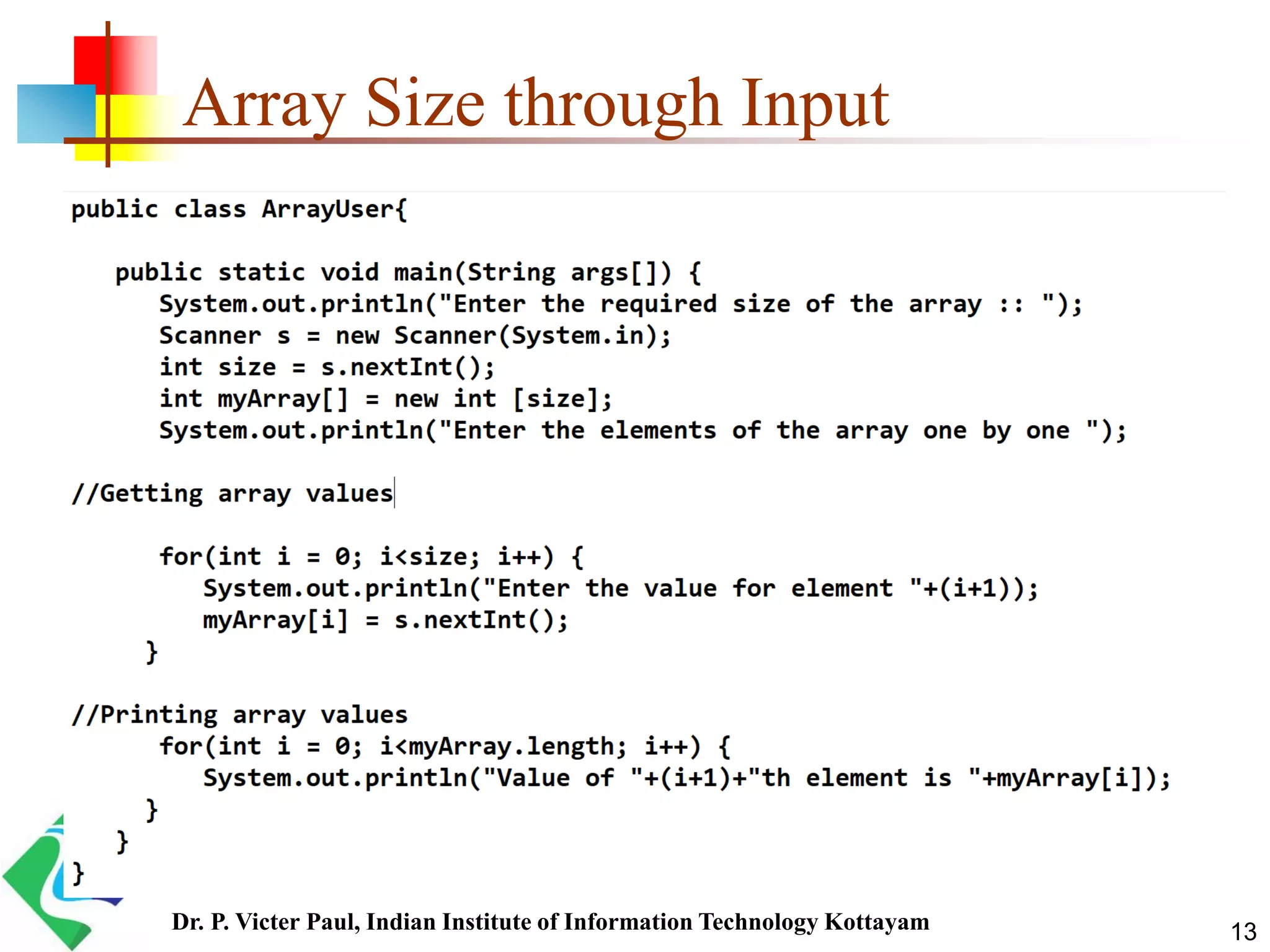
![What happens if …
long[] primes = new long[20];
primes[25]=33;
….
Runtime Error:
Exception in thread “main” java.lang.ArrayIndexOutOfBoundsException: 25
at MorePrimes.main(MorePrimes.java:6)
14Dr. P. Victer Paul, Indian Institute of Information Technology Kottayam](https://image.slidesharecdn.com/java-arraysconcepts-200510150556/75/Java-Arrays-Concepts-14-2048.jpg)
![15
Copying Arrays (The Wrong Way)
Often, in a program, you need to duplicate an array or a part of an array.
In such cases you could attempt to use the assignment statement (=), as
follows:
myList1= new int[10];
myList2 = new int[10];
myList2 = myList1;
Contents
of myList1
list1
Contents
of myList2
list2
Before the assignment
Contents
of myList1
list1
Contents
of myList2
list2
After the assignment
Garbage
Dr. P. Victer Paul, Indian Institute of Information Technology Kottayam](https://image.slidesharecdn.com/java-arraysconcepts-200510150556/75/Java-Arrays-Concepts-15-2048.jpg)
![16
Copying Arrays (The Correct Way)
Using a loop:
int[] sourceArray = {2, 3, 1, 5, 10};
int[] targetArray = new int[sourceArray.length];
for (int i = 0; i < sourceArrays.length; i++)
targetArray[i] = sourceArray[i];
Dr. P. Victer Paul, Indian Institute of Information Technology Kottayam](https://image.slidesharecdn.com/java-arraysconcepts-200510150556/75/Java-Arrays-Concepts-16-2048.jpg)
![17
Passing Arrays to Methods
Defining a method that takes an int array as a formal
parameter
public static void printArray(int[] array) {
for (int i = 0; i < array.length; i++) {
System.out.print(array[i] + " ");
}
}
Invoking the method with an int array as an argument
(actual parameter)
int[] list = {3, 1, 2, 6, 4, 2};
printArray(list);
Dr. P. Victer Paul, Indian Institute of Information Technology Kottayam](https://image.slidesharecdn.com/java-arraysconcepts-200510150556/75/Java-Arrays-Concepts-17-2048.jpg)
![18
Returning an Array from a Method
Define the method that returns an array
public static int[] reverse(int[] list) {
int[] result = new int[list.length];
for (int i = 0, j = result.length - 1;
i < list.length; i++, j--) {
result[j] = list[i];
}
return result;
}
Call the method
int[] list1 = {1, 2, 3, 4, 5, 6};
int[] list2 = reverse(list1);
Dr. P. Victer Paul, Indian Institute of Information Technology Kottayam](https://image.slidesharecdn.com/java-arraysconcepts-200510150556/75/Java-Arrays-Concepts-18-2048.jpg)
![Arrays of Arrays
Two-Dimensional arrays
float[][] temperature=new float[10][365];
10 arrays each having 365 elements
First index: specifies array (row)
Second Index: specifies element in that array (column)
In JAVA float is 4 bytes, total Size=4*10*365=14,600 bytes
19Dr. P. Victer Paul, Indian Institute of Information Technology Kottayam](https://image.slidesharecdn.com/java-arraysconcepts-200510150556/75/Java-Arrays-Concepts-19-2048.jpg)
![Graphical Representation
0 1 2 3 4 5 6 7 8 9
0 1 2 3 4 5 6 7 8 9
0 1 2 3 4 5 6 7 8 9
Sample[0]
Sample[1]
Sample[2]
20Dr. P. Victer Paul, Indian Institute of Information Technology Kottayam](https://image.slidesharecdn.com/java-arraysconcepts-200510150556/75/Java-Arrays-Concepts-20-2048.jpg)
![Initializing Array of Arrays
int[][] array2D = {
{99, 42, 74, 83, 100},
{90, 91, 72, 88, 95},
{88, 61, 74, 89, 96},
{61, 89, 82, 98, 93},
{93, 73, 75, 78, 99},
};
//5 arrays with 5 elements each
21Dr. P. Victer Paul, Indian Institute of Information Technology Kottayam](https://image.slidesharecdn.com/java-arraysconcepts-200510150556/75/Java-Arrays-Concepts-21-2048.jpg)
![Sample Program
class unevenExample3
{
public static void main( String[] arg )
{ // declare and construct a 2D array
int[][] uneven = { { 1, 9, 4 }, { 0, 2}, { 0, 1, 2, 3, 4 } };
// print out the array
for ( int row=0; row < uneven.length; row++ ) //changes row
{
System.out.print("Row " + row + ": ");
for ( int col=0; col < uneven[row].length; col++ ) //changes column
System.out.print( uneven[row][col] + " ");
System.out.println();
}
}
}
22Dr. P. Victer Paul, Indian Institute of Information Technology Kottayam](https://image.slidesharecdn.com/java-arraysconcepts-200510150556/75/Java-Arrays-Concepts-22-2048.jpg)
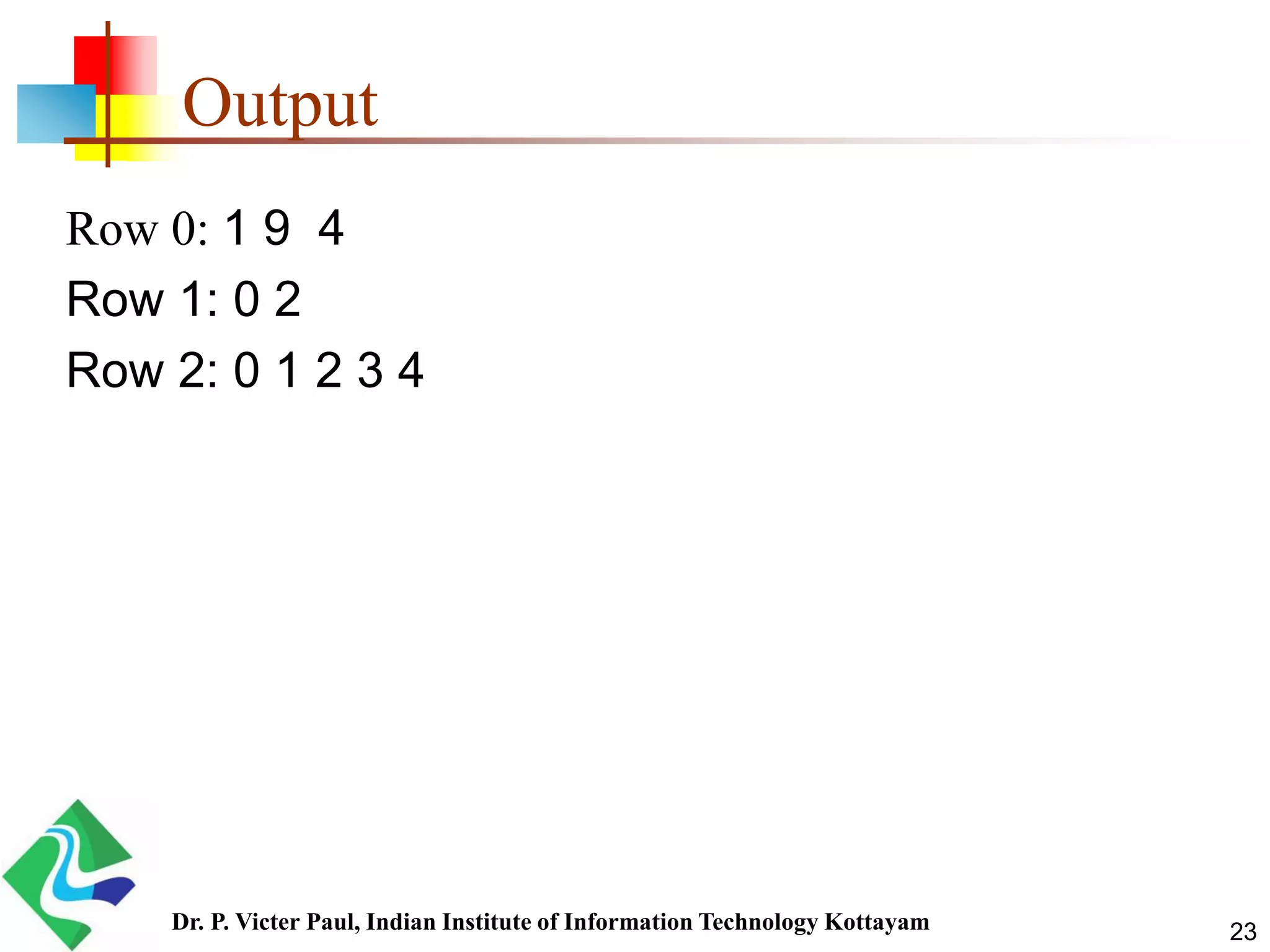
![Multidimensional Arrays
A farmer has 10 farms of beans each in 5 countries, and
each farm has 30 fields!
Three-dimensional array
long[][][] beans=new long[5][10][30];
//beans[country][farm][fields]
24Dr. P. Victer Paul, Indian Institute of Information Technology Kottayam](https://image.slidesharecdn.com/java-arraysconcepts-200510150556/75/Java-Arrays-Concepts-24-2048.jpg)
![25
Examples of Arrays Processing
Initializing an array with random values between 0.0
and 99.0
double[] myList = new double[4];
for (int i = 0; i < myList.length; i++) {
myList[i] = Math.random() * 100;
}
Printing an array
for (int i = 0; i < myList.length; i++) {
System.out.print(myList[i] + " ");
}
Dr. P. Victer Paul, Indian Institute of Information Technology Kottayam](https://image.slidesharecdn.com/java-arraysconcepts-200510150556/75/Java-Arrays-Concepts-25-2048.jpg)
![26
Summing all elements
double total = 0;
for (int i = 0; i < myList.length; i++) {
total += myList[i];
}
Finding the largest element
double max = myList[0];
for (int i = 1; i < myList.length; i++) {
if (myList[i] > max)
max = myList[i];
}
Dr. P. Victer Paul, Indian Institute of Information Technology Kottayam](https://image.slidesharecdn.com/java-arraysconcepts-200510150556/75/Java-Arrays-Concepts-26-2048.jpg)
![27
Finding the smallest index of the largest element
double max = myList[0];
int indexOfMax = 0;
for (int i = 1; i < myList.length; i++) {
if (myList[i] > max) {
max = myList[i];
indexOfMax = i;
}
}
Dr. P. Victer Paul, Indian Institute of Information Technology Kottayam](https://image.slidesharecdn.com/java-arraysconcepts-200510150556/75/Java-Arrays-Concepts-27-2048.jpg)
